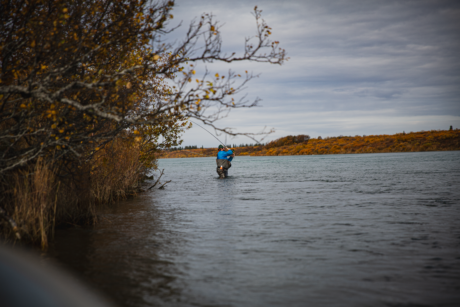
If you’re an avid two-handed rod fly angler looking to expand your skills and tackle challenging fishing spots, learning cack-handed spey casting could be your next big breakthrough. This technique, while it may sound unusual, is a valuable addition to any angler’s repertoire.
What is Cack-handed Spey Casting?
Cack-handed spey casting refers to making a spey cast with your dominant hand still on top of the rod, but casting over your non-dominant shoulder—essentially, the opposite side from a traditional spey cast. The cack-handed cast is beneficial when wind or obstacles make a standard cast unsafe or impractical. This technique allows you to cast effectively from different positions along a river, particularly when fishing on the opposite side from your dominant hand.
Why Learn This Technique?
- Versatility: Cack-handed casting enables you to fish effectively on both sides of a river, expanding your fishing opportunities.
- Physical Relief: It can be beneficial for those with shoulder issues, as it reduces strain on the dominant side.
- Adapting to the Environment: When obstacles like overhanging trees or high banks are present, this technique enables casting in confined spaces.
- Efficiency: By mastering cack-handed casting, you can quickly switch between different casting styles without changing your position, maximizing your time on the water.
Steps for a Cack-Handed Spey Cast:
- Grip: Keep your dominant hand on top of the rod, as you would for a standard spey cast. You do not switch your hands’ positions.
- Stance: Stand with your feet shoulder-width apart, facing the target. If you’re right-handed, you’ll be casting over your left (non-dominant) shoulder.
- Rod Position: Bring the rod across your body so the rod tip points downstream on your non-dominant side.
- D-Loop Formation: Sweep the rod up and back over your non-dominant shoulder, forming a D-loop on that side. This is the key difference from a standard cast, where the D-loop forms on your dominant side.
- Anchor Placement: Make sure your fly and line anchor on the water in front of you, on the same side as your D-loop (non-dominant side).
- Forward Cast: Accelerate the rod forward, casting over your non-dominant shoulder, keeping your dominant hand on top throughout the motion.
Summary Table: Standard vs. Cack-Handed Spey Cast
| Feature | Standard Spey Cast | Cack-Handed Spey Cast |
| D-Loop Side | Dominate shoulder | Non-dominant Shoulder |
| Hand Position | Dominant Hand on Top | Dominant Hand on Top |
The structure and fundamentals of a Cack-Handed are the same as standard Spey Cast. It’s just performed on the “other side.” Just as rhythm, timing, placement, and movement are all a part of a regular Spey cast, so they are with a cack-handed Spey cast.
Tips for Learning
- This cast can feel awkward at first, as your muscle memory is tuned to casting over your dominant shoulder. Practice helps build comfort and efficiency.
- Cack-handed casting is especially effective when you have a downstream wind coming from your dominant side, as it keeps the fly and line safely away from your body.
- Watching slow-motion demonstrations can help visualize the motion and timing needed for a smooth cack-handed cast.
- Start Slow: Please take your time to understand the mechanics of the cast before you try to increase speed or distance.
- Focus: Be mindful of your timing and rhythm.
- Be Patient: Remember, it’s normal to feel awkward at first. With time, your non-dominant hand will become more coordinated.
- Seek Guidance: Consider taking lessons from an experienced caster to fine-tune your technique, timing, and rhythm.
Learning cack-handed spey casting may seem challenging at first, but the rewards are well worth the effort. Not only will it make you a more versatile angler, but it will also open up new fishing opportunities and help you land that fish of a lifetime in spots you couldn’t reach before. With practice, cack-handed spey casting becomes a valuable tool for safe and effective casting in oddball conditions.
So, next time you’re out on the river, why not give cack-handed casting a try? You’ll discover a whole new dimension to your two-handed fly fishing experience. Shoot, you might find you’re better at a cack-handed cast rather than a standard cast.
Leave a Reply